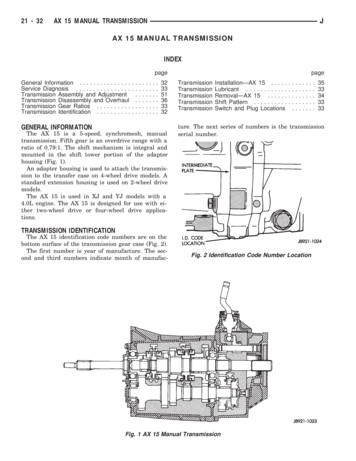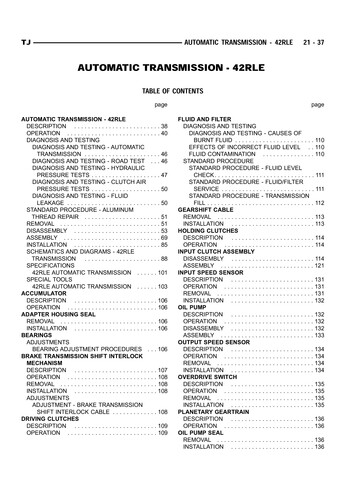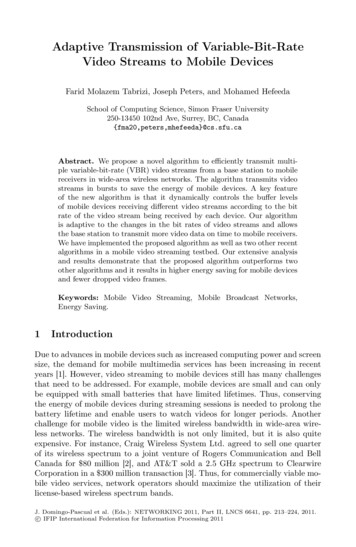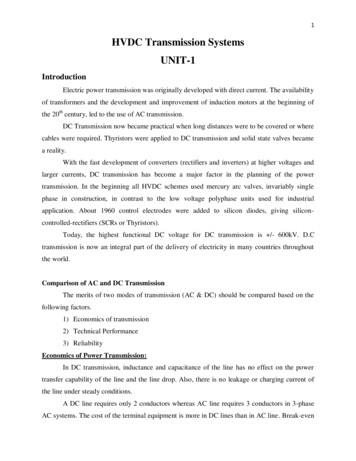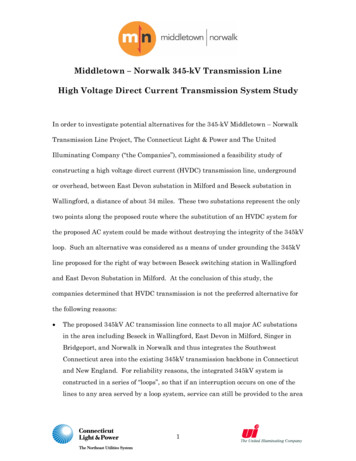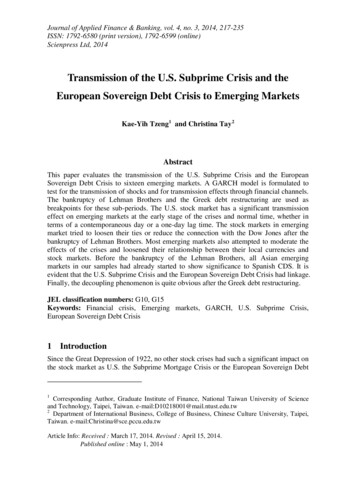
Transcription
Journal of Applied Finance & Banking, vol. 4, no. 3, 2014, 217-235ISSN: 1792-6580 (print version), 1792-6599 (online)Scienpress Ltd, 2014Transmission of the U.S. Subprime Crisis and theEuropean Sovereign Debt Crisis to Emerging MarketsKae-Yih Tzeng1 and Christina Tay 2AbstractThis paper evaluates the transmission of the U.S. Subprime Crisis and the EuropeanSovereign Debt Crisis to sixteen emerging markets. A GARCH model is formulated totest for the transmission of shocks and for transmission effects through financial channels.The bankruptcy of Lehman Brothers and the Greek debt restructuring are used asbreakpoints for these sub-periods. The U.S. stock market has a significant transmissioneffect on emerging markets at the early stage of the crises and normal time, whether interms of a contemporaneous day or a one-day lag time. The stock markets in emergingmarket tried to loosen their ties or reduce the connection with the Dow Jones after thebankruptcy of Lehman Brothers. Most emerging markets also attempted to moderate theeffects of the crises and loosened their relationship between their local currencies andstock markets. Before the bankruptcy of the Lehman Brothers, all Asian emergingmarkets in our samples had already started to show significance to Spanish CDS. It isevident that the U.S. Subprime Crisis and the European Sovereign Debt Crisis had linkage.Finally, the decoupling phenomenon is quite obvious after the Greek debt restructuring.JEL classification numbers: G10, G15Keywords: Financial crisis, Emerging markets, GARCH, U.S. Subprime Crisis,European Sovereign Debt Crisis1 IntroductionSince the Great Depression of 1922, no other stock crises had such a significant impact onthe stock market as U.S. the Subprime Mortgage Crisis or the European Sovereign Debt1Corresponding Author, Graduate Institute of Finance, National Taiwan University of Scienceand Technology, Taipei, Taiwan. e-mail:D10218001@mail.ntust.edu.tw2Department of International Business, College of Business, Chinese Culture University, Taipei,Taiwan. e-mail:Christina@sce.pccu.edu.twArticle Info: Received : March 17, 2014. Revised : April 15, 2014.Published online : May 1, 2014
218Kae-Yih Tzeng and Christina TayCrisis. The East Asian crisis in 1997-1998, the Russian default in 1998, and theArgentinian crisis in 2002, all showed a limited and short-term impact on stock markets.Most affected countries managed to decouple from these crises rather quickly and safely.On the contrary, the global stock and economic crisis of 2007-2013, which originated inthe U.S. subprime mortgage market, triggered a severe chain reaction from the U.S. toEurope and across emerging markets (EM, hereinafter). Even the high growth rates of EMwere unable to withstand the impact of such crises. The global transmission mechanism isa key factor of damage to EM.The Subprime Mortgage Crisis in the U.S. or the European Sovereign Debt Crisisemanated from advanced economies and had a chain effect on EM, affecting EM evenmore seriously than advanced economies. Our interest in this topic is partly related to thewidespread view that prior to these two crises, many policy makers in EM had advocatedeconomic integration policies to their national advantages by abolishing tariffs andloosening stock restrictions to facilitate the movement of capital. As Claessens, et al.(2010) explain, although economic integration provides national benefits, it also bringssignificant risks. A frictionless global financial market will not bring the international risksharing but instead, will bring about more dynamics.This paper seeks to contribute to scant and existing studies on how transmissionmechanisms work in the global stock market in several ways. First, this paper is one ofthe earliest attempts to investigate transmission mechanisms in emerging economiesduring the Subprime Mortgage Crisis and the Sovereign Debt Crisis. Second, although thefinancial channel is an effective transmission mechanism, there have been few attempts toestablish a direct relationship between the stock markets of EM and the U.S. stock marketor the Euro CDS, simultaneously. Third, this paper is an extension of ideas that builds onthe work on Grammatikos & Vermeulen (2012) whose focus is on the impact of these twomajor crises on the EU countries, whereas in this paper we extend this study to include 16emerging economies, which to our knowledge is an area that is rarely tapped on. Fourth, itis also one of the attempts to investigate concomitantly the impacts of these two crises onemerging markets. Existing or previous researches of recent crises deem the SubprimeMortgage Crisis and the Sovereign Debt Crisis as separate and independent events. In thispaper, we argue that these two crises should not be isolated from each other and find thatthese two crises to be closely correlated to each other.To do this, we use data of the U.S. and of 16 EM, the latter of which are members of theMSCI EM as of the December 2013, based on daily stock market indices. The sensitivityof stock markets in these 16 EM to both the Subprime Mortgage Crisis and to SovereignDebt problems as well as to exchange rate movements for the different stages of these twomajor crises are also investigated. By comparing different periods of time, we can testmore explicitly for the transmission of the stock crises. In addition, we distinguish amongdifferent sub-periods within the stock crises, where the bankruptcy of the LehmanBrothers on September 15, 2008 and the Greek debt restructuring on March 9, 2012 areused as breakpoints.This paper is organized as follows. Section 2 is our literature review. Section 3 covers thedata, methodology and the empirical findings. Section 4 presents the conclusion.
U.S. Subprime Crisis and the European Sovereign Debt Crisis to Emerging Markets2192 Literature ReviewIn recent years, there has been a growing pool of literature that addresses transmissionmechanisms of various financial crises. Although two transmission mechanisms identifiedin existing literature commonly include the real channel (Alessandria, et al. 2010; Eaton,et al. 2011; Levchenko et al. 2010) and the financial channel, the financial channel plays amore important role in recent years. Financial channels are also found to have a greaterimpact than real channels. Pericoli & Sbracia (2003) find the stock market and stockintermediaries to be immensely influential international transmission mechanisms. Rose& Spiegel (2010) find that transmission mechanisms through both the stock and realchannels in the 2008 crisis. Four indicators are used in their study including changes inreal GDP, stock market, credit rating, and exchange rate to check for internationallinkages. Financial channels are found to have a greater impact than real channels. Thao,et al. (2013) investigate the financial transmission in East Asian economies through equitymarkets including developed countries, EM and frontier markets by employing theirconditional correlations based on the GARCH model. They find the transmission ofSupreme Mortgage Crisis to East Asian equity markets varies over time and highercorrelations to other markets in the region than U.S. Berkmen, et al. (2009) investigate thedriving factors behind the disappointed forecast errors during the 2009 stock crisis. Theyalso find that the financial channel is more important than the real channel for EM,explaining that the stock market shocks suffered by EM which possessed more leverageon domestic finance or more short-term debt, suffered more. Based on the behavior ofexchange rates and events, researchers find financial transmission to be more effective.Fratzscher (2009) investigates the impact of the U.S. dollar appreciation during the U.S.stock crisis against the expectation of a weak U.S. dollar. By analyzing the transmissionchannel in exchange rates, they find that countries whose fundamentals and stockexposure to the U.S. to be statistically significant and economically meaningful. Dooleyand Hutchison (2009) conducted an “event study” to find out how strong the SubprimeMortgage Crisis “news” transmission has on EM. They point out that financial andeconomic news emanating from Subprime Mortgage Crisis had a large impact on EM,statistically and economically.The Subprime Mortgage Crisis and Sovereign Debt Crisis provide us with a perfectsituation to observe the chain reaction of these two major crises and the linkages betweenthem. Ehrmann and Fratzscher (2004) find that the U.S. stock market can influence up tomore than 25% of European Union(EU, hereinafter) economies, given any normal period.In addition, the U.S. Subprime Crisis also had a massive influence on the global economy.Toughening of the world economy and vastly reducing resources in international capitalswere common measures during this period of time. Investors became more cautious andlending was also reduced, which in turn led to a decline in investment capitals. Highleveraged EU countries started to face the cruel stock market environment which waswhen the European Sovereign Debt Crisis exploded.Ehrmann, Fratzscher, and Mehl (2009) share with us the reasons behind the transmissionand find that the degree of integration with the U.S. market is a major factor in globaltransmission mechanism, followed by country risk. Bussiere, et al. (2013) explains thesovereign risk by measuring the gaps between sovereign bonds in EU and pointed out thatthe sovereign bond spread among EU countries was quite minimal before the SubprimeMortgage Crisis, implying that sovereign bonds which were issued were considered asdefault-free. Thus, the sovereign default risk in EU countries is not considered an
220Kae-Yih Tzeng and Christina Tayimportant issue. However, after the Subprime Mortgage Crisis, the increased spread ofsovereign default risk in EU countries was significantly high, especially in southern EUcountries. Investors became more cautious and treated sovereign default risk moreseriously after the Subprime Mortgage Crisis. Obviously, the Subprime Mortgage Crisishad triggered a chain reaction in EU countries. Buessiere (2013) points out that a crisiscan be an indicator as to whether a country is vulnerable or not, and that withdrawal ofmoney from risky countries will increase risk in the future.An increasing body of literature exists on the research of Subprime Mortgage Crisis andEuropean Sovereign Debt Crisis. Most existing literatures treat these two major crises asindependent events except for Bussiere, et al. (2013) and Grammatikos and Vermeulen(2012). This paper assumes these two crises are interdependent of each other andinvestigates the influences on EM by extending the model of Grammatikos andVermeulen (2012). However, this paper differentiates from the study by Grammatikosand Vermeulen (2012) in the following manner. Firstly, we posit that since emergingcountries own their own local currencies, unlike EU countries which use a commonEurodollar is their currency base, emerging countries may response differently to thethese two crises from EU countries. Grammatikos and Vermeulen investigated EUMember Union using a common EU currency to measure the stock performance. Theyfound that the relationship behind EU dollar and the stock market to be quite differentover different time periods. The relationship was positive and significant between the EUdollar and stock market in times of the crises, which is different from normal time. Someof EU countries were considered vulnerable during the Sovereign Debt Crisis due to thepoor economic situation in the EU and also because EU possess a common currency,retarding them from the ability to adjust ‘local’ currency to improve their export foreconomic growth purposes. Poorer EU countries lost their credit in the internationalcapital market and could not find resources to bail them out of this dilemma. Secondly,due to the progression of these two crises, this paper extends the research period to theJune 30, 2013 and set the Greek debt restructuring as additional milestone in order toinvestigate the decoupling effect of both crises which adds to existing research.The following section presents the data and empirical methodology through which weanalyze the transmission of shocks on EM.3 Data and Methodology3.1 DataThe U.S. and 16 EM daily-base stock market indices are obtained from Bloomberg andC-money. Data of EM are of countries who are members of the MSCI EM as of Dec.2013. The MSCI EM Indices were launched on Dec 31, 1987. Data prior to these launchdates is back-tested data (i.e. calculations of how the index might have performed overthat time period had the index existed). The MSCI EM Index captures large and mid-caprepresentation across 21 EM countries with 824 constituents covering approximately 85%of the free float-adjusted market capitalization in each country.The daily-base stock market index is obtained from the Bloomberg and C-money for theU.S. and 16 EM. Data of emerging market countries is obtained from the MSCI EM Indexas of the year Dec. 2013. There are a total of 21 EM in the MSCI database. However,since EM are more susceptible to macro-economic factors, we select countries whose
U.S. Subprime Crisis and the European Sovereign Debt Crisis to Emerging Markets221market capitalizations are greater than 100 billion USD at the year 2012 from the WorldBank database and come up with a total count of 16 countries for our research. The list ofemerging market countries is listed in Table 1. Data on currency exchange rates and theSpanish CDS are retrieved from the Bloomberg database, too. The exchange rate ismeasured in U.S. dollar per unit of local currency for each respective country.In our study, we use the definition of crises period as defined in the study byGrammatikos and Vermeulen (2012). The Subprime Mortgage Crisis began on February27, 2007. From the timeline given by the Federal Reserve Bank of St. Louis, thebeginning event of the Subprime Mortgage Crisis was when the Freddie Mac Press wasreleased on February 27, 2007. The message was “The Federal Home Loan MortgageCorporation (Freddie Mac) announces that it will no longer buy the most risky subprimemortgages and mortgage-related securities”. For the purposes of comparison betweencrises and normal times, the study by Grammatikos and Vermeulen (2012) chooseJanuary 1, 2003 as their beginning date of the research. Similarly, we also use January 1,2003 as our starting date.Table 1: List of EM and market capitalizationCountryChinaIndiaBrazilSouth KoreaRussiaTaiwan*South ilippinesColombiaPolandmarket tes: The definition of market capitalization is explained by the World Bank as follows:1.Market capitalization is the share price times the number of shares outstanding.2.Listed companies are the domestically incorporated companies on the country's stockexchanges at the end of the year 20123.(*)Data on Taiwan’s market capitalization (USD 732.68 billion) is obtained from thedatabase of the Taiwan Stock Exchange. The data on Taiwan’s market capitalization isunavailable from the World Bank data.4. Source: World Bank. Data are in U.S. billion dollars.The milestones of the crises are prescribed as follows. The bankruptcy of the LehmanBrothers on September 15, 2008 is used as the milestone for the Subprime MortgageCrisis by Grammatikos and Vermeulen (2012). Many existing research also use this timeas a prime date including Eichengreen, et al. (2012), Dooley and Hutchison (2009), andDidier et al. (2010). Eichengreen, et al. (2012) claim that the bankruptcy of the Lehman
222Kae-Yih Tzeng and Christina TayBrothers let investors more concretely to identify the risk in the U.S. Subprime MortgageCrisis and the imminent effects of a global recession. In this paper, the Greek debtrestructuring on March 9, 2012 is prescribed as the other milestone for the EuropeanSovereign Debt Crisis. Zettelmeyer, et al. (2013) point out that Greek debt restructuring ishistoric significance in many respects: (1) a new world record of restructured volume andcredit losses, (2) first major debt restructuring in Europe after World War II, and (3) awatershed event in the history of the European crisis. The time of these milestones arepresented in the Figure 1.Stock Market Index of MSCI Emerging market, Dow Jones and Euro Stoxx 502.2Lehman BankruptcyGreek debt restructuring2-Dow Jones1.81.61.4-EmergingMarket1.2-Stoxx 5010.8Crises 04/4/12003/6/12003/1/1Figure 1: Stock Market Index of MSCI EM, Dow Jones, and Euro Stoxx 50Source: BloombergA ten-year Spanish government bond CDS is included in the later part of this paper. Thestudy by Grammatikos and Vermeulen (2012) use the Greek CDS in order to investigatethe impact of the European Sovereign Debt Crisis on the stock markets in EM, where theGreek government bond CDS is used as a European Sovereign Debt Crisis indicator dueto the public strong attention. The ending of sample period in Grammatikos andVermeulen (2012) was as of August 31, 2010. Greece announced restructuring of itsgovernment debt with its private-sector creditors in order to secure more bail-out moneyon March 9, 2012. Under this restructuring program, bondholders lost 75% of theirinvestment by writing down a 53.3% in the value of Greek bonds. As a result, the Greekmarket price of CDS changed dramatically. In order to avoid the dynamics of such achange, we use the ten-year Spanish government bond CDS in our paper, which alsoobtained strong public attention at that time.
U.S. Subprime Crisis and the European Sovereign Debt Crisis to Emerging Markets2233.2 MethodologyMany different methodologies are often used to measure how shocks are transmittedinternationally. Hamao, et al. (1990), Engle et al. (1990) suggest the GARCH method.Forbes & Rigobon (2002) suggest using the correlation model, while Bae, et al. (2003)suggest using the logit model, when dealing with daily data. Engle (2001) suggested thatthe GARCH (1,1) is a robust methodology when dealing with time series data that issubject to high volatility. The basic variance concept of GARCH is as follows:ht α1 β1ht-1 γ1ε2t-1Where h is the variance relative to a past variance and residual. GARCH (1,1) with anadditional lag term can detect the speed of a message, particularly for the equity index.Thus, we use the concept of GARCH (1,1) as an additional lag term in our regressionmodel. We formulate four equations to capture the effects and behavior during across fourtime periods: (1) a full period, which starts from January 1, 2003 and ends June, 30 2013,(2) crises period, which starts from February 27, 2007 and ends June 30, 2013, (3) apost-bankruptcy of the Lehman Brothers period, which starts from September 15, 2008and ends June 30, 2013, and finally, (4) a post-Greek debt restructuring which starts fromMarch 12, 2012 and ends June 30, 2013.We postulate the following equation for a full sample period from January 1, 2003 to June,30 2013 as follows:Rj,t C αRj,t-1 βjRus,t γjRus,t-1 δjEj,t εj,t(1)Where C is a constant and ε j,t is a random disturbance term. All the above variables arecomputed using [100*(log (Pt)-log(Pt-1))]. The dependent variable, Rj,t is designed tocapture the independent variables of the stock market behavior including a one-day timelag, the different time zones of the stock markets of pairing countries with the U.S, andthe local currency exchange rate of return. Rj,t denotes the stock market return in country,j, at time, t, and Rj,t 100*(log(Pt)-log(Pt-1)). Rj,t-1 is a one-day lag, t-1 return of stockmarket in country, j. Rus,t is the return of the U.S. Dow Jones, at time, t. Rus,t-1 is one-daytime lag, t-1, of the U.S. Dow Jones. Ej,t is exchange rate of return which is measured interms of the return of a U.S. dollar per unit of currency in each country, j, in time, t.A time dummy variable is created and included in equation (2) to test for stock marketbehavior:Rj,t C αRj,t-1 βjRus,t βjcrisDjcrisRus,t γjRus,t-1 γjcrisDjcrisRus,t-1 δjEj,t δjcrisDjcrisEj,t εj,t(2)Where C is a constant and εj,t is a random disturbance term. Djcris refers to a dummyvariable which equals to 1 during the period of the crises from February 27, 2007 to June30, 2013, or 0, if otherwise. βjcris, γjcris, δj cris are coefficients of the independent variablesduring the crises period which may postulate positive or negative values.Applying the GARCH methodology to our regression equation, we postulate regressionequation (3) that attempts to capture the transmission effects of the European SovereignDebt Crisis during the different stages within crises. The period we use starts fromFebruary 27, 2007 which is denoted as the beginning of the crises to June 30, 2013. The
224Kae-Yih Tzeng and Christina TaySpanish CDS is used as a measurement for the European Sovereign Debt Crisis. Theperiod after the bankruptcy of the Lehman Brothers is denoted by a dummy variableDjpostL.Rj,t C αRj,t-1 βjRus,t βjpostLDjpostLRus,t γjRus,t-1 γjpostLDjpostLRus,t-1 δjEj,t δjpostLDjpostLEj,t ζpostL postLDjCDSt εj,t(3)jCDSt ζjWhere C is a constant and εj,t is a random disturbance term. DjpostL refers to a time dummyvariable which equals to 1 if the time is after the bankruptcy of the Lehman Brothers thatis between September 15, 2008 and June 30, 2013, and 0, if otherwise. CDSt refers to theSpanish CDS, at time, t. βjpostL, γjpostL, δj postL, ζj postL are coefficients of the independentvariables after the post Leman Brother bankruptcy periods.In order to investigate the behavior in final stages and decoupling from the two crises, wedesign regression equation (4) that attempts to find the transmission phenomenon after theGreek debt restructuring. The period of regression equation (4) starts from February 27,2007 which is denoted the beginning of the crises to June 30 2013. DjpostGr is created torefer to a time dummy variable which equals to 1 if the time is after the Greek debtrestructuring that is between March 12, 2012 and June 30, 2013, and 0, if otherwise.βjpostGr, γjpostGr, δj postGr, ζj postGr are coefficients of the independent variables after the postGreek debt restructuring.Rj,t C αRj,t-1 βjRus,t βjpostLDjpostLRus,t βjpostGrDjpostGrRus,t γjRus,t-1 γjpostLDjpostLRus,t-1 γjpostGr postGrDjRus,t-1 δjEj,t δjpostLDjpostLEj,t δjpostGrDjpostGrEj,t ζjCDSt ζjpostLDjpostLCDSt ζjpostGrpostGrDjCDSt εj,t(4)Where C is a constant, and εj,t is a random disturbance term.3.3 Empirical Analysis3.3.1 The stock marketIn descriptive statistics, the periods of stock crises have been divided into two major timeperiods: before crises and crises, to observe whether there is a difference in stock marketbehavior during these two time periods. Table 2 shows the stock market behavior usingthe means and variances, before as well as after the time of the bankruptcy of the LehmanBrothers and after the Greek debt restructuring within crises.Before the crises, all of the stock markets enjoyed an upward trend and most of stockmarkets of EM outperformed the Dow Jones. This pattern is consistent with the results inthe study by Grammatikos & Vermeulen (2012) which also showed a positivephenomenon in the EU before the Subprime Mortgage Crisis. Between the start of crisesand Lehman Brother’s Bankruptcy, most of the stock markets decreased in EM,producing negative mean values except for India, South Korea, Indonesia and Brazil.After the bankruptcy of the Lehman Brothers, the stock markets of EM recovered rathersoon, all of them producing positive mean average values. Our results yield a contrastingphenomenon from the study by Grammatikos & Vermeulen (2012). Most the averagemeans for EM posed positive values during crises times. One of the explanations for sucha difference may be the length of time used in our research data. The ending period of thedata used by the study by Grammatikos & Vermeulen (2012) was as of August 31, 2010,
U.S. Subprime Crisis and the European Sovereign Debt Crisis to Emerging Markets225at a time when most of countries were still facing a tough economic situation. On theother hand, the ending period of our study is of June 30, 2013, at that time when most ofthe countries were already recovering from the financial crises.The rate of volatility before crises was quite minimal showing that the stock markets inthese EM were not so dynamic. However, the variance increased sharply during crisesperiod. The value was sometimes greater the double variance of pre-crises, implying thatthere was an enormous fluctuation in the stock markets of EM during crises period. Themost intensive period of volatility is different within these EM. One-half of EMexperienced an intense between the start date of the crises and the bankruptcy of theLehman Brothers. The other half experienced such intensity from the time of thebankruptcy of the Lehman Brothers to the Greek debt restructuring. After the Greek debtrestructuring, the impact of the crises began to fade out, and the volatilities of EM becamesmaller than the pre-crises periods.3.3.2 Exchange RateThe variability in exchange rate of return is used to determine its susceptibility within thestages of financial crises. Table 3 shows the empirical results of the means and variancesof the exchange rate movements.Before the crises, most of currencies of EM appreciated against the U.S. dollar except forIndonesia and Mexico. During the time of crises, more than half of the EM depreciatedagainst the U.S. dollar. When we check the total reserves of each EM (measured incurrent USD), EM with high reserves seemed to try to depreciate their currency againstthe U.S. dollar, except for China and Taiwan whose country reserves were also relativelyhigher. This phenomenon is in line with the results of the study by Fratzscher (2009) whofinds that some macroeconomic fundamentals such as foreign exchange reserves, play animportant factor during a financial crisis. After the Greek debt restructuring, the currencyexchange rates of all of the EM depreciated against U.S. dollar, except for China. In effect,the individual currencies in EM allowed flexibility in policies unlike the Eurodollar, andcreated an EM group behavior against the U.S. dollar.The volatility of the currency exchange rate of return for EM is rather similar to that ofthe stock market. Before crises, there is a low volatility in the exchange rate of return inthese EM. More dynamic fluctuations in currency exchange rates returns are apparent forall EM in crises. The intensive period of volatility in most countries is the period after thebankruptcy of the Lehman Brothers to Greek debt restructuring while stock markethappened before Lehman Brother corruption in crises. In the study by Grammatikos &Vermeulen (2012) uses only one common currency: the Eurodollar. In our study, eachemerging country has its own unique currency in which individual governments had morecontrol over their local currencies compared to the countries in the EU, in times of crises.
226Kae-Yih Tzeng and Christina TayTable 2: Descriptive Statistics of Daily Stock Market ReturnsMeanFull sampleBefore-CrisesperiodRegionCrises PeriodCountryFull subperiodChinaIndiaSouth ssiaEurope,PolandMiddle East ,Turkeyand AfricaSouth AfricaU.S.Dow JonesEuropeSTOXX 0.04650.01750.0246VarianceFull 590.01090.0046-0.0136FromLehmanBeforeAfter GreekBankruptcyLehmanDebtto 4-0.01130.00680.0194-0.0297-0.01260.0046Full sampleBefore-CrisesperiodFull 10.74590.22230.10870.2367Crises PeriodFull .38160.37420.5479FromLehmanBeforeAfter GreekBankruptcyLehmanDebtto 50.32610.73200.3140Note: This table presents descriptive statistics (means and variances) for the daily stock market returns of the 16 EM. The full sampleperiod is from January 1, 2003 to June 30, 2013. The full sample period is then divided two sub-periods: before crises and during theperiod of crises. The full sub-period before these crises begins on January 1, 2003 and ends 26 February, 2007. The period of crises isfrom 27 February, 2007 to June 30, 2013. The period of crises is divided three periods: (1) before the bankruptcy of the Lehman Brothers,(2) from the time of the bankruptcy of the Lehman Brothers to the Greek debt restructuring, and (3) after the Greek debt restructuring. Allthe above daily stock ma
Journal of Applied Finance & Banking, vol. 4, no. 3, 2014, 217-235 ISSN: 1792-6580 (print version), 1792-6599 (online) Scienpress Ltd, 2014 Transmission of the U.S. Subprime Crisis and the European Sovereign Debt Crisis to Emerging Markets . Kae-Yih Tzeng. 1. and Christina Tay. 2. Abstract




